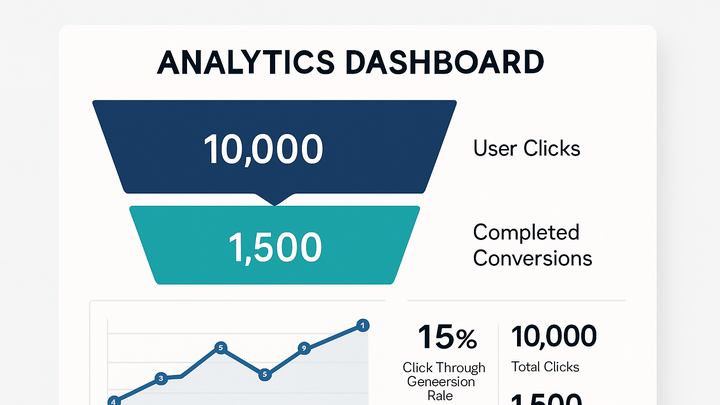Published on 2025-06-28T02:33:23Z
What is Click-Through Conversion? Examples of Click-Through Conversion
Click-through conversion refers to the process where a user clicks on a link, ad, or call-to-action (CTA) and subsequently completes a desired action, such as making a purchase or filling out a form. This metric goes beyond mere click-through rate (CTR) by tracking the end outcome of clicks rather than just the click itself. In the analytics industry, click-through conversions help marketers and analysts understand the true effectiveness of their campaigns and channels. By attributing conversions back to specific clicks, businesses can optimize ad spend, improve user journeys, and increase ROI. Tools like PlainSignal offer simple, cookie-free analytics to capture click events, while platforms like Google Analytics 4 (GA4) enable advanced event tracking and attribution models. Implementing click-through conversion tracking typically involves embedding tracking scripts or tags, defining conversion events, and configuring your analytics dashboard to report on these events. With proper setup and analysis, click-through conversion metrics become a powerful driver for data-informed decision-making.
Click-through conversion
Measures how many user clicks lead to completed goals, tracked via tools like PlainSignal or GA4 for campaign insights.
Definition and Overview
An introduction to what click-through conversions are and how they differ from related metrics.
-
Click-through conversion explained
A click-through conversion is recorded when a user clicks on a link or CTA and completes a predefined action within a set timeframe.
-
Distinction from ctr and conversion rate
Unlike click-through rate (CTR), which measures clicks per impression, click-through conversion focuses on actions taken after the click, aligning with conversion rate metrics.
Why Click-Through Conversion Matters
Understanding the importance of measuring click-through conversions for digital marketing success.
-
Measure campaign effectiveness
Shows how well specific ads or CTAs drive users to complete valuable actions, informing budget allocation and strategy.
-
Optimize user journey
Reveals drop-off points between click and conversion, enabling improvements in landing pages and funnel experiences.
Tracking Implementation
Steps to set up click-through conversion tracking using popular analytics tools.
-
Tracking with PlainSignal
To enable click-through conversion tracking with PlainSignal, include the following snippet in your site’s HTML:
<link rel="preconnect" href="//eu.plainsignal.com/" crossorigin /> <script defer data-do="yourwebsitedomain.com" data-id="0GQV1xmtzQQ" data-api="//eu.plainsignal.com" src="//cdn.plainsignal.com/plainsignal-min.js"></script>After installation, configure your conversion goals in the PlainSignal dashboard to capture click events as conversions.
-
Tracking with GA4
For Google Analytics 4 (GA4), fire a custom event on click and configure it as a conversion in the GA4 UI. Example using gtag.js:
gtag('event', 'click_through_conversion', { 'event_category': 'CTA Buttons', 'event_label': 'Signup Now', 'value': 1 });After sending the event, navigate to Admin > Events in GA4 to mark your custom event as a conversion.
Best Practices
Recommended approaches to ensure accurate and meaningful click-through conversion data.
-
Define clear conversion goals
Specify what constitutes a conversion (e.g., purchase, sign-up) and ensure all stakeholders agree on the criteria.
-
Use appropriate attribution models
Select an attribution model (last-click, first-click, or data-driven) that reflects your customer journey and marketing mix.
-
Regularly audit tracking
Periodically test and validate your tracking implementation to catch tagging errors or missing data.
Common Use Cases
Examples of how click-through conversion tracking is applied across different industries and objectives.
-
E-commerce checkout
Track clicks on ‘Buy Now’ buttons and measure how many lead to completed purchases, helping optimize product pages and promotions.
-
Lead generation
Measure clicks on downloadable asset links or contact CTAs that result in form submissions or qualified leads.
